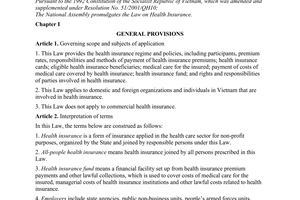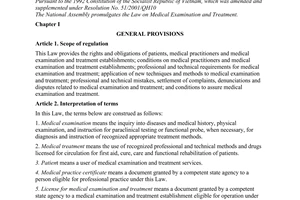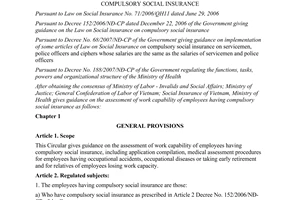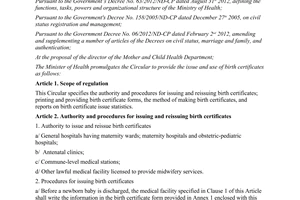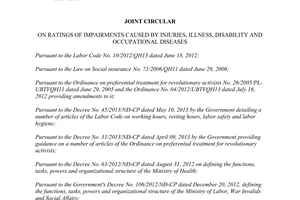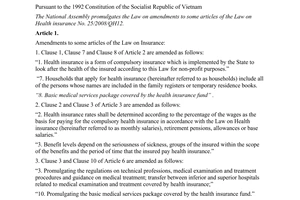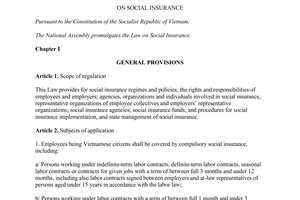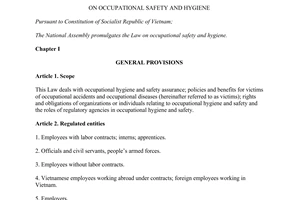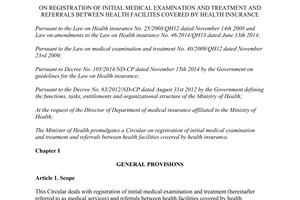Circular 14/2016/TT-BYT guidelines for some articles health of the law on social insurance đã được thay thế bởi Circular 56/2017/TT-BYT guidelines Law social insurance Law on occupational safety and hygiene và được áp dụng kể từ ngày 01/03/2018.
Nội dung toàn văn Circular 14/2016/TT-BYT guidelines for some articles health of the law on social insurance
|
MINISTRY OF
HEALTH |
SOCIALIST REPUBLIC
OF VIETNAM |
|
No. 14/2016/TT-BYT |
Hanoi, May 12, 2016 |
CIRCULAR
GUIDELINES FOR SOME ARTICLES ON HEALTH OF THE LAW ON SOCIAL INSURANCE
Pursuant to the Law on Social insurance No. 58/2014/QH13 dated November 20, 2014;
Pursuant to the Law on Occupational hygiene and safety No. 84/2015/QH13 dated June 25, 2015;
Pursuant to the Law on Health insurance No. 25/2008/QH12 dated November 14, 2008 and the Law No. 46/2014/QH13 dated June 13, 2014 on amendments to the Law on Health insurance;
Pursuant to the Law on Medical examination and treatment No. 40/2009/QH12 dated November 23, 2009;
Pursuant to the Government's Decree No. 63/2012/ND-CP dated August 31, 2012 defining the functions, tasks, powers and organizational structure of the Ministry of Health;
At the request of Director of the Legal Department, Director of Medical Examination & Treatment Administration, Director of Mother and Child Health Department, Director of Health Insurance Department,
The Minister of Health promulgates a Circular providing guidelines for some Articles on health of the Law on Social insurance.
Chapter I
GENERAL PROVISIONS
Article 1. Scope
This Circular provides for:
1. List of diseases, the power to determine diseases eligible for lump-sum social insurance payout.
2. Documents and procedures for assessment of work capacity reduction as the basis for workers and their relatives to receive social insurance payout.
3. Issuance of discharge notes, birth certificate, copies of medical records, medical record summaries, confirmation of maternity leave, confirmation of poor postpartum health and confirmation of eligibility to receive social insurance benefits.
4. List of diseases that require long-term treatment in Appendix 1 enclosed herewith.
Article 2. Regulated entities
1. Workers participating in social insurance as specified in Clause 1 and Clause 4 Article 2 of the Law on Social insurance.
2. Workers specified in Clause 1 of this Article whose social insurance participation period is reserved or retired workers pending pension or monthly benefits; voluntary social insurance participants who have paid compulsory social insurance premiums for at least 20 years.
3. Relatives of dead workers who participated in social insurance applying for assessment of work capacity reduction to receive death benefits for workers (hereinafter referred to as worker’s relative)
Article 3. Definitions
For the purpose of this Circular, the terms below are construed as follows:
1. Worker means an employee who participates in compulsory social insurance in accordance with the Law on Social insurance.
2. Sick leave means a period of time over which a worker is not healthy enough to work and is required by a physician to take a sick leave.
3. First assessment means the first assessment of work capacity reduction of a person who:
a) suffers from an occupational accident;
b) suffers from an occupational disease;
c) is participating in social insurance or having social insurance participation period reserved;
d) is a relative of a social insurance participant and has reduced work capacity that needs monthly benefits;
dd) suffers from any of the diseases specified in Clause 6 Article 4 of this Circular;
4. Reassessment means assessment from the second time onwards of work capacity reduction of a person who suffers from a disease or disability because of an occupational accident or occupational disease which recurs or develops after assessment.
5. General assessment means general assessment of work capacity reduction of a person who suffers from both an occupational accident and an occupational disease; suffers from multiple occupational accidents or multiple occupational diseases.
6. Assessment by Central Medical Assessment Council means an assessment carried out by Central Medical Assessment Council in the cases beyond the capacity of a Provincial Medical Assessment Council.
7. Reassessment by Central Medical Assessment Council means a reassessment carried out by Central Medical Assessment Council after an appeal against the result given by Provincial Medical Assessment Council is filed.
8. Final reassessment means the final reassessment carried out by a Medical Assessment Council established by the Minister of Health after an appeal against the result given by Central Medical Assessment Council is filed.
9. Valid copy means a copy that is extracted from the original book or authenticated by a competent authority or has been compared with the original.
10. Medical record summary means the summary of a medical record prescribed by regulations of law on medical examination and treatment.
Chapter II
LIST OF DISEASES, POWER TO DETERMINE DISEASES ELIGIBLE FOR LUMP-SUM SOCIAL INSURANCE PAYOUT
Article 4. List of diseases eligible for lump-sum social insurance payout
1. The diseases specified in Point c Clause 1 Article 60 of the Law on Social insurance.
2. Diseases that result in at least 81% work capacity reduction which is unrecoverable.
Article 5. The power to determine diseases eligible for lump-sum social insurance payout
1. The diseases eligible for lump-sum social insurance payout mentioned in Clause 1 Article 4 of this Circular must be determined at medical facilities specified in Clause 1, 2, 4, 5 and 8 Article 4 of Circular No. 40/2015/TT-BYT.
2. Work capacity reduction rate mentioned in Clause 2 Article 4 of this Circular shall be determined by a Medical Assessment Council.
Article 6. Documents proving a patient’s eligibility for lump-sum social insurance payout
1. A person who suffers from any of the diseases mentioned in Clause 1 Article 4 of this Circular shall submit a medical record summary specified in Clause 1 Article 5 of this Circular.
2. A person who suffers from any of the diseases mentioned in Clause 2 Article 4 of this Circular shall submit a medical examination record according to Template No. 02 in Appendix 2 enclosed herewith.
Chapter III
ASSESSMENT AS THE BASIS FOR SOCIAL INSURANCE PAYOUT
Section 1. ASSESSMENT DOCUMENTS
Article 7. Cases of assessment
1. Assessment of disability due to an occupational accident.
2. Assessment of occupational diseases.
3. Assessment as the basis for provision of pension or death benefits.
Article 8. Application for first assessment
1. First assessment of disability due to an occupational accident:
a) The employer’s letter of introduction according to the template in Appendix 3 enclosed herewith;
b) A valid copy of the injury confirmation issued by the health facility that provided treatment for the worker according to the template in Appendix 4 enclosed herewith.
2. First assessment of occupational diseases:
a) The employer's letter of introduction according to the template in Appendix 3 enclosed herewith or a written request for assessment prepared by the worker whose social insurance participation period is reserved or a retired worker pending pension or monthly benefits;
b) A discharge note or occupational disease record or medical record summary.
3. Assessment as the basis for provision of pension for a person paying compulsory social insurance:
a) The employer’s letter of introduction according to the template in Appendix 3 enclosed herewith;
b) A valid copy of any of the following documents (if any): medical record summary, disability confirmation, discharge note, documents about examination or treatment of diseases, injuries or disabilities such as: health book, prescriptions, follow-up appointment forms, outpatient medical record summary.
4. Assessment pending early provision of pension for a worker paying social insurance premiums or a worker whose social insurance participation period is reserved or a retired worker pending pension or monthly benefits; assessment as the basis for provision of death benefits; assessment of a retired worker or a worker suffering an occupational disease whose social insurance participation period is reserved:
a) A written request for examination according to the template in Appendix 7 enclosed herewith.
b) A valid copy of any of the following documents (if any): medical record summary, disability confirmation, discharge note, documents about examination or treatment of diseases, injuries or disabilities such as: health book, prescriptions, follow-up appointment forms, outpatient medical record summary.
Article 9. Application for assessment of relapse
1. Assessment of occupational accident relapse:
a) A written request for assessment according to the template in Appendix 7 enclosed herewith;
b) Documents about treatment of injury relapse:
- For inpatient treatment: a valid copy of the discharge note according to the template in Appendix 5 or medical record summary according to the template in Appendix 6 enclosed herewith.
- For outpatient treatment: valid copies of documents about examination and/or treatment of diseases, injuries or disabilities caused by the occupational accident such as: health book, prescriptions, follow-up appointment forms or outpatient medical record summary.
c) Previous medical assessment record.
2. Assessment of occupational disease relapse:
a) A written request for assessment according to the template in Appendix 7 enclosed herewith;
b) Documents about the occupational disease or health book that contains information about the discovery of the occupational disease;
c) Documents about treatment of the occupational disease relapse:
- For inpatient treatment of the occupational disease or diseases, injuries or disabilities related to the occupational disease relapse: a valid copy of the discharge note according to the template in Appendix 5 or medical record summary according to the template in Appendix 6 enclosed herewith;
- For outpatient treatment: valid copies of documents about examination and/or treatment of diseases, injuries or disabilities caused by the occupational disease relapse such as: health book, prescriptions, follow-up appointment forms or outpatient medical record summary.
d) A valid copy of the previous medical assessment record.
Article 10. Application for general reassessment
1. The employer's letter of introduction according to the template in Appendix 3 enclosed herewith or a written request for assessment according to Appendix 7 enclosed herewith if the worker is having his/her social insurance participation period reserved or has retired.
2. A valid copy of the previous medical assessment record.
3. Other documents specified in Clause 1 and Clause 2 Article 8 or Clause 1 and Clause 2 Article 9 depending on the patient and type of assessment.
Article 11. Application for assessment by Central Medical Assessment Council
1. Ann application for assessment by Central Medical Assessment Council shall bear the signature and seal of the head of the governing organization of the Medical Assessment Council.
2. Valid copies of the application for assessment specified in Article 8, 9 or 10 of this Circular depending on the patient and type of assessment.
3. Any of the following documents:
a) A valid copy of the medical assessment record prepared by the Provincial Medical Assessment Council if an assessment has been carried out;
b) Minutes of meeting of the Medical Assessment Council saying the case is beyond its capacity if no assessment has been carried out.
Article 12. Application for reassessment by Central Medical Assessment Council or final reassessment
1. Application for reassessment by Central Medical Assessment Council:
a) If the reassessment is requested by an organization: a written request for reassessment by Central Medical Assessment Council prepared by the Ministry of Health, the Ministry of Labor, War Invalids and Social Affairs, Social Security Administration of Vietnam or the employer;
b) If the reassessment is requested by an individual: a written request for reassessment by Central Medical Assessment Council prepared by the Provincial Medical Assessment Council bearing the signature and seal of the head of the governing organization of the Medical Assessment Council. The request shall specify the person that disagrees with the conclusion given by the Council and requests the reassessment and be enclosed with a written request for reassessment prepared by such person;
c) Valid copies of the application for assessment specified in Article 8, 9 or 10 of this Circular depending on the patient and type of assessment;
d) The medical assessment record prepared by the Provincial Medical Assessment Council.
2. Application for final reassessment:
a) If the reassessment is requested by an organization: a written request for reassessment by Central Medical Assessment Council prepared by the Ministry of Health, the Ministry of Labor, War Invalids and Social Affairs, Social Security Administration of Vietnam or the employer;
b) If the reassessment is requested by an individual: a written request for reassessment by Central Medical Assessment Council prepared by the Provincial Medical Assessment Council bearing the signature and seal of the head of the governing organization of the Medical Assessment Council. The request shall specify the person that disagrees with the conclusion given by the Central Medical Assessment Council and requests the reassessment and be enclosed with a written request for final reassessment prepared by such person;
c) Valid copies of the application for assessment specified in Article 8, 9 or 10 of this Circular depending on the patient and type of assessment;
d) The medical assessment record prepared by the Central Medical Assessment Council.
Article 13. Responsibility for preparing the application
1. The worker shall prepare the application and send it to the Medical Assessment Council in the following cases:
a) The worker is having his/her social insurance participation period reserved and applies for assessment to receive pension;
b) The worker is having his/her social insurance participation period reserved and applies for assessment to receive lump-sum social insurance payout;
c) A relative of the worker applies for assessment to receive monthly benefits.
d) A retired worker applies for assessment of relapse.
2. The employer shall prepare the application and send it to the Medical Assessment Council in cases other than those specified in Clause 1, Clause 3 and Clause 4 of this Article.
3. Governing organization of the Provincial Medical Assessment Council shall prepare the application for reassessment by Central Medical Assessment Council
4. Governing organization of the Central Medical Assessment Council shall prepare the application for final reassessment.
Section 2. PROCEDURES FOR MEDICAL ASSESSMENT
Article 14. Time limits
1. Reassessment of an occupational accident or occupational disease shall be carried out at least after 02 years (24 months) from the day on which Medical Assessment Council gives a conclusion of the rate of work capacity reduction because of the occupational accident or occupational disease.
2. Where the worker’s health deteriorates rapidly, the governing organization of the Medical Assessment Council shall request the Chairperson or Deputy Chairperson of the Medical Assessment Council to consider carrying out a reassessment before the time specified in Clause 1 of this Article.
Article 15. Power to carry out medical assessment
1. A Provincial Medical Assessment Council is entitled to:
a) Carry out first assessment for workers or workers’ relatives (who applies to receive death benefits);
b) Carry out assessment of relapse and general assessment for workers, unless it has been carried out by another Medical Assessment Council;
c) Send patients other health facilities for clinical examination, testing or medical imaging where necessary.
2. Medical Assessment Councils affiliated to the Ministry of Public Security, the Ministry of National Defense, the Ministry of Transport are entitled to carry out assessments for workers of units under their management. To be specific:
a) Carry out first assessment for workers or workers’ relatives (who applies to receive death benefits);
b) Carry out assessment of relapse and general assessment for workers;
c) Send patients to other health facilities for clinical examination, testing or medical imaging where necessary.
3. Central Medical Assessment Council is entitled to:
a) Carry out first assessment for workers or workers’ relatives (who applies to receive death benefits);
b) Carry out assessment of relapse and general assessment for workers;
c) Carry out assessment of relapse and general assessment for workers who have undergone first assessment by Provincial Medical Assessment Councils;
d) Carry out reassessment requested by Provincial Medical Assessment Council and the Minister of Health.
Article 16. Receipt of application for medical assessment
1. Applications for medical assessment shall be received as follows:
a) The governing organization of a Provincial Medical Assessment Council or Central Medical Assessment Council shall receive applications for first assessment, reassessment or general assessment;
b) The governing organization of Central Medical Assessment Council shall receive applications for reassessment by Central Medical Assessment Council;
c) Regarding applications for final reassessment:
The individual or organization that disagrees with the result given by Central Medical Assessment Council shall send an application for final reassessment to the Ministry of Health.
2. After an application is received, the governing organization of the Medical Assessment Council or the Ministry of Health shall send the applicant a receipt note according to the template in Appendix 9 enclosed herewith.
3. If the application is satisfactory:
a) The Medical Assessment Council shall carry out assessment within 30 days from the day written on the receipt note;
b) The Minister of Health shall establish a Final Medical Assessment Council to carry out the final reassessment within 20 days from the day written on the receipt note.
Within 10 working days from the day on which a decision to establish the Final Medical Assessment Council, the Council shall carry out the final assessment.
4. If the application is not satisfactory, within 10 working days from the day written on the receipt note, the governing organization of the Medical Assessment Council or the Ministry of Health shall send a written notice to the applicant.
Article 17. Medical assessment procedures
1. Comparison: the person who carries out the medical assessment shall compare the patient with one of his/her documents: ID card, passport, confirmation by the police department of the commune where he/she resides (whether temporarily or permanently) which bears the patient’s picture (the picture must be taken on a white background within 6 months before the application is made out and bear a seal of the police).
2. Overall examination: a physician of the governing organization of the Medical Assessment Council shall act as an assessor who carries out the overall examination and prescribes specialist examinations and subclinical examinations. If such physician is not an assessor, the overall examination shall be carried out and the head of the governing organization shall prescribes specialist examinations and subclinical examinations.
3. Specialist examinations: specialists shall examine and draw conclusion according to prescriptions of the competent person.
4. Consultation: Chairperson of the Council or head of the governing organization of the Medical Assessment Council shall chair the consultation before the meeting of the Council. Where necessary, the governing organization of the Medical Assessment Council shall invite the patient and specialists to participate in the meeting.
5. Meeting of Medical Assessment Council:
a) Conditions for holding the meeting:
- The meeting is participated by more than 50% of its members, two of whom must be specialists;
- The meeting is chaired by the chairperson or deputy chairperson of the Medical Assessment Council.
b) Conclusion given by Medical Assessment Council:
- The conclusion shall be given by voting by every member of the Council. In case of dissenting opinions, the chair of the meeting shall consider prescribing additional examinations or treatment before holding a ballot.
- In case of ballot, the result shall be announced at the meeting. The conclusion must be concurred with by more than 50% of participating members.
c) The conclusion shall be given in writing according to the template in Appendix 2 enclosed herewith. The governing organization of the Medical Assessment Council shall issue the medical assessment record.
6. The medical assessment record shall be circulated and retained by the governing organization of the Medical Assessment Council as follows:
a) 02 copies shall be sent to the patient who shall submit 01 copy to the social insurance authority (via the employer if the patient is still working);
b) 01 copy shall be kept by the applicant for medical assessment and 01 copy to the Medical Assessment Council that gave the result appealed against.
c) 01 copy shall retain at the governing organization of the Medical Assessment Council.
In case of assessment of relapse, reassessment by Central Medical Assessment Council and final reassessment, the conclusion must contain conclusions of all previous examinations.
7. The conclusion given by Medical Assessment Council is permanent, unless another conclusion is given by another Medical Assessment Council at the same or superior level.
8. Medical assessment documents shall be retained at the governing organization of the Medical Assessment Council in accordance with regulations of law on document retention.
Article 18. Assessment of work capacity reduction
1. Work capacity reduction shall be assessed in accordance with Circular No. 28/2013/TTLT-BYT-BLDTBXH.
2. Methods for assessment of work capacity reduction are specified in Circular No. 28/2013/TTLT-BYT-BLDTBXH Assessment of work capacity reduction for general assessment:
a) Where a person who is already suffering from an injury or disease or occupational diseases catches another injury or disease or occupational disease which causes the same disability:
The rate of work capacity reduction shall be determined according to results of examination of all the injuries, diseases or occupational diseases.
b) Where a person who is already suffering from an injury or disease or occupational diseases catches another injury or disease or occupational disease which causes a different disability:
The rate of work capacity reduction caused by the new injury, disease or occupational disease shall be aggregate with that of the previous occupational accident or occupational disease written in the previous medical assessment record.
c) In case of relapse of a person’s injury, disease or occupational disease, the rate of work capacity reduction shall be determined according to result of examination of the injury, disease or occupational disease.
3. The rate of work capacity reduction specified in this Article is valid until the next medical assessment record is issued.
Chapter IV
DISCHARGE NOTE, BIRTH CERTIFICATE, CERTIFICATION OF MATERNITY LEAVE, CERTIFICATION OF INADEQUATE POSTPARTUM HEALTH
Article 19. Discharge note
1. The following entities have the power to issue discharge notes:
a) Licensed health facilities providing inpatient treatment;
b) Practitioners at a health facility specified in Point a of this Clause authorized by the head of such facility.
2. The discharge note template is provided in Appendix 5 enclosed herewith.
Article 20. Birth certificate
1. The following entities have the power to issue birth certificates:
a) Licensed health facilities providing midwifery services;
b) Practitioners at a health facility specified in Point a of this Clause authorized by the head of such facility.
2. Procedures for issuance of birth certificates are specified in Circular No. 17/2012/TT-BYT and Circular No. 34/2015/TT-BYT.
3. The birth certificate template is provided in Appendix 10 enclosed herewith.
Article 21. Confirmation of maternity leave
1. The following entities are entitled to issue confirmations of maternity leave:
a) Any hospital having an obstetrics department;
b) Any general hospital and Medical Assessment Council;
c) Practitioners at a health facility specified in Point a or b of this Clause authorized by the head of such facility.
2. The issuance of confirmation of maternity leave by a general hospital or practitioner thereof shall be based on the result of consultation held by departments relevant to the patient’s sickness.
3. Templates of confirmation of maternity leave:
a) The template provided Appendix 12 enclosed herewith shall be used by hospitals specified in Clause 1 of this Article for pregnant workers paying compulsory social insurance who receive outpatient treatment.
b) The template provided Appendix 11 enclosed herewith shall be used by hospitals specified in Clause 1 of this Article for pregnant workers who resigned and receive outpatient treatment;
c) Template No. 2 provided in Appendix 2 enclosed herewith shall be used by Medical Assessment Councils;
d) Discharge note template provided in Appendix 5 of medical record summary template provided in Appendix 6 enclosed herewith.
4. The confirmation of maternity leave specified in Clause 2 of this Article must specifically describe the patient’s health and necessary duration (days) of maternity leave. The duration shall comply with instructions of the Ministry of Health and the patient’s health.
5. The conclusion specified in Clause 2 of this Article is valid for 6 months from the date written on the medical assessment record and only used for grant of maternity benefits.
Article 22. Issuance of confirmation of poor postpartum health
1. Provincial Medical Assessment Councils and above have the power to issue confirmations of poor postpartum health.
2. The template of medical assessment record is provided in Appendix 2 enclosed herewith, the conclusion in which shall specifies that the mother is not healthy enough to provide care for her newborn child.
3. The conclusion specified in Clause 2 of this Article is valid for 6 months from the date written on the medical assessment record and only used for grant of maternity benefits.
Chapter V
ISSUANCE AND MANAGEMENT OF CONFIRMATION OF ELIGIBILITY TO RECEIVE SOCIAL INSURANCE BENEFITS
Article 23. Rules for issuance of confirmation of eligibility to receive social insurance benefits
1. The issuance of a confirmation of eligibility to receive social insurance benefits must:
a) be issued by a competent authority specified in Article 23 hereof;
b) be appropriate for the scope of operation of the health facility that issues the confirmation which is approved by a competent authority;
c) be appropriate for the patient’s health and instructions of the Ministry of Health.
2. If a worker is issued with more than one confirmations of eligibility to receive social insurance benefits by various departments, the one with the longest duration shall apply.
Article 24. Power to issue confirmation of eligibility for social insurance benefits
1. Licensed health facilities.
2. Practitioners of health facilities specified in Point a of this Clause whose signatures have been registered with a social insurance authority.
Article 25. Types of confirmation of eligibility to receive social insurance benefits
1. The template provided in Appendix 5 enclosed herewith shall be used for workers receiving inpatient treatment or children aged under 7 of workers.
2. The template provided in Appendix 12 enclosed herewith shall be used for workers receiving outpatient treatment.
If a patient needs to take a leave for outpatient treatment after discharged from the hospital, the social insurance authority shall provide social insurance benefits according to the leave duration (days) written on the discharge note.
Article 26. Provision of blank confirmations of eligibility to receive social insurance benefits
1. The health facility that wishes to issue confirmation of eligibility to receive social insurance benefits shall send a written request for provision of blank confirmation of eligibility to receive social insurance benefits and a list of practitioners authorized to sign such confirmations according to the template in Appendix 13 enclosed herewith to the social insurance authority of the province or district where the facility is located.
2. Within 15 days from the receipt of the request, the social insurance authority shall provide blank confirmation of eligibility to receive social insurance benefits to the health facility. If the request is rejected, a written notice and explanation shall be sent.
Chapter VI
ORGANIZATION OF IMPLEMENTATION
Article 27. Responsibilities of affiliates of the Ministry of Health
1. Medical Examination & Treatment Administration shall:
a) Organize reviews of the implementation of this Circular nationwide;
b) Carry out inspections and deal with violations against this Circular in accordance with applicable law.
2. Mother and Child Health Department shall:
a) Cooperate with Medical Examination & Treatment Administration in organizing the implementation and reviews of implementation of this Circular nationwide;
b) Carry out inspections and deal with violations against this Circular in accordance with applicable law.
Article 28. Responsibilities of Social Security Administration of Vietnam
1. Provide instructions for social insurance authorities on implementation of this Circular.
2. Unify management of printing and provision of blank confirmation of eligibility to receive social insurance benefits.
3. Instruct health facilities to register issuance of confirmation of eligibility to receive social insurance benefits and post the list of facilities entitled to issue confirmation of eligibility to receive social insurance benefits on the websites of Social Security Administration of Vietnam and provincial social insurance authorities. Inspect the issuance of confirmation of eligibility to receive social insurance benefits by health facilities.
4. Ex offico review the implementation of this Circular and propose amendments to this Circular to competent authorities.
Article 29. Responsibilities of Provincial Departments of Health
1. Organize reviews of the implementation of this Circular within their provinces.
2. Carry out inspections and deal with violations against this Circular in accordance with applicable law.
Article 30. Responsibilities of health facilities and Medical Assessment Councils
1. Disseminate the content of this Circular among their practitioners and employees.
2. Provide documents for workers as the basis for receipt of social insurance benefits in accordance with this Circular; examine the content of documents specified in this Circular prepared by their practitioners and take legal responsibility for the accuracy and truthfulness thereof.
3. Update data about medical examination and treatment, issuance of documents and medical assessment records on the national medical examination and treatment database which is connected to the data of social insurance authorities.
4. Transferring health facilities shall provide copies of referral notes bearing their seals on request.
Chapter VII
IMPLEMENTATION CLAUSE
Article 31. Effect
This Circular comes into force on July 01, 2016.
Circular No. 11/1999/TTLB-BYT-BHXH Circular No. 34/2013/TT-BYT Circular No. 07/2010/TT-BYT template of discharge note enclosed with Decision No. 4069/2001/QD-BYT of the Minister of Health; birth certificate template enclosed with Circular No. 17/2012/TT-BYT are no longer effective from the effective date of this Circular.
Article 32. Transition clause
Confirmation of eligibility to receive social insurance benefits, discharge notes and birth certificates issued before the promulgation date of this Circular are effective until December 31, 2016 inclusive.
Article 33. Organization of implementation
Chief of the Ministry Office, Directors of Departments of the Ministry of Health, Directors of Provincial Departments of Health, Directors of health authorities and relevant units are responsible for the implementation of this Circular.
Difficulties that arise during the implementation of this Circular should be reported to the Ministry of Health for consideration./.
|
|
PP MINISTER |
APPENDIX 1
LIST OF DISEASES THAT REQUIRE LONG-TERM TREATMENT
(enclosed with Circular No. 14/2016/TT-BYT dated May
12, 2016)
|
No. |
Disease |
ICD 10 Category |
|
I |
Infectious and parasistic diseases |
|
|
1. |
Tuberculosis during treatment and sequelae |
A15 to A19. |
|
2. |
Sequelae of tuberculosis of bones and joints |
B90.2 |
|
3. |
Leprosy (Hansen’s disease) and sequelae |
A30, B92 |
|
4. |
Chronic viral hepatitis B |
B1.8.1. |
|
5. |
Chronic viral hepatitis C |
B1.8.2 |
|
6. |
Acquired immunodeficiency syndrome (HIV/AIDS) |
B20 to B24, Z21 |
|
7. |
Sequelae of viral, infectious and parasitic encephalitis and meningitis |
B94.1, B94.8, B94.9 |
|
8. |
Candidal meningitis, cerebral cryptococcosis |
B37.5, B45.1 |
|
II |
Neoplasms |
|
|
9. |
Malignant neoplasms and in situ neoplasms |
C00 to C97; D00 to D09 |
|
10. |
Benign neoplasm of bone and articular cartilage |
D16 |
|
11. |
Neoplasm of uncertain or unknown behavior |
D37 to D48 |
|
III |
Diseases of the blood and blood-forming organs and certain disorders involving the immune mechanism |
|
|
12. |
Polycythemia vera |
D45 |
|
13. |
Myelodysplastic syndromes |
D46 |
|
14. |
Myeloproliferative disease |
D47.1 |
|
15. |
Thalassemia |
D56 |
|
16. |
Hereditary haemolytic anaemias |
D58 |
|
17. |
Autoimmune haemolytic anaemias |
D59.1 |
|
18. |
Paroxysmal nocturnal haemoglobinuria (Marchiafava syndrome) |
D59.5 |
|
19. |
Aplastic anaemia |
D61.9 |
|
20. |
Hereditary factor VIII deficiency (Hemophilia A) |
D66 |
|
21. |
Hereditary factor IX deficiency (Hemophilia B) |
D67 |
|
22. |
Von Willebrand disease |
D68.0 |
|
23. |
Qualitative platelet defects |
D69.1 |
|
24. |
Idiopathic thrombocytopenic purpura (Evans syndrome) |
D69.3 |
|
25. |
Primary polycythaemia |
D75.2 |
|
26. |
Haemophagocytic syndrome, infection-associated |
D76.2 |
|
27. |
Hypergammaglobulinaemia, unspecified |
D89.2 |
|
IV |
Endocrine, nutritional and metabolic diseases |
|
|
28. |
Hypothyroidism |
E03 |
|
29. |
Nontoxic goitre |
E04 |
|
30. |
Hyperthyroidism (Basedow) |
E05 |
|
31. |
Subacute thyroiditis (de Quervain and chronic) |
E06.1 |
|
32. |
Type 1 and Type 2 diabetes mellitus |
E10 to E14 |
|
33. |
Hyperfunction of pituitary gland |
E22 |
|
34. |
Hypofunction and other disorders of pituitary gland |
E23 |
|
35. |
Cushing disease |
E24.0 |
|
36. |
Adrenocortical insufficiency |
E27.4 |
|
37. |
Hypoparathyroidism |
E20 |
|
38. |
Hyperparathyroidism and other disorders of parathyroid gland |
E21 |
|
39. |
Wilson disease |
E83.0 |
|
40. |
Postprocedural hypothyroidism |
E89.0 |
|
V |
Mental and behavioural disorders |
- |
|
41. |
Dementia in Alzheimer disease |
F00 |
|
42. |
Vascular dementia |
F01 |
|
43. |
Dementia in other diseases classified elsewhere |
F02 |
|
44. |
Unspecified dementia |
F03 |
|
45. |
Mental disorders due to brain damage and dysfunction and to physical disease |
F06 |
|
46. |
Mental and behavioural disorders due to use of alcohol |
F10 |
|
47. |
Mental and behavioural disorders due to use of opioids |
F11 |
|
48. |
Mental and behavioural disorders due to use of cannabinoids |
F12 |
|
49. |
Mental and behavioural disorders due to use of hallucinogens |
F16 |
|
50. |
Schizophrenia |
F20 |
|
51. |
Paranoid schizophrenia |
F21 |
|
52. |
Persistent delusional disorders |
F22 |
|
53. |
Schizoaffective disorders |
F25 |
|
54. |
Bipolar affective disorder |
F31 |
|
55. |
Depressive episode |
F32 |
|
56. |
Recurrent depressive disorder |
F33 |
|
57. |
Persistent mood [affective] disorders |
F34 |
|
58. |
Phobic anxiety disorders |
F40 |
|
59. |
Other anxiety disorders |
F41 |
|
60. |
Obsessive-compulsive disorder |
F42 |
|
61. |
Somatoform disorders |
F45 |
|
62. |
Disorders of adult personality and behaviour |
F60 to F69 |
|
63. |
Mental retardation |
F70 to F79 |
|
64. |
Disorders of psychological development |
F80 to F89 |
|
65. |
Behavioural and emotional disorders with onset usually occurring in childhood and adolescence |
F90 to F98 |
|
VI |
Diseases of the nervous system |
|
|
66. |
Systemic atrophies primarily affecting central nervous system in diseases classified elsewhere |
G13 |
|
67. |
Parkinson disease |
G20 |
|
68. |
Secondary parkinsonism |
G21 |
|
69. |
Dystonia |
G24 |
|
70. |
Alzheimer disease |
G30 |
|
71. |
Multiple sclerosis |
G35 |
|
72. |
Subacute necrotizing myelitis |
G37.4 |
|
73. |
Epilepsy |
G40 |
|
74. |
Myasthenia gravis |
G70.0 |
|
VII |
Diseases of the eye and adnexa |
|
|
75. |
Dry eye syndrome |
H04.1.2 |
|
76. |
Keratitis |
H16 |
|
77. |
Lens-induced iridocyclitis |
H20.2 |
|
78. |
Harada disease |
H30.8.1 |
|
79. |
Chorioretinitis, choroiditis |
H30.9.1, H30.9.2 |
|
80. |
Proliferative vitreo-retinopathy with retinal detachment |
H33.4.1 |
|
81. |
Central retinal vein occlusion |
H34.8 |
|
82. |
Retinal vasculitis |
H35.0.6 |
|
83. |
Central serous chorioretinopathy |
H35.7.1 |
|
84. |
Retinal disorders due to atherosclerosis |
H36.6 |
|
85. |
Glaucoma |
B40 |
|
86. |
Sympathetic uveitis |
H44.1.2 |
|
87. |
Nutritional optic neuropathy |
H46.2 |
|
88. |
Toxic optic neuropathy |
H46.3 |
|
VIII |
Diseases of the ear and mastoid process |
|
|
89. |
Ménière disease |
H81.0 |
|
90. |
Sudden idiopathic hearing loss |
H91.2 |
|
91. |
Progressive hearing loss |
|
|
92. |
Brain, meninges herniation into the ear - mastoid |
|
|
93. |
Cord VII tumor |
|
|
94. |
Cord VIII tumor |
|
|
95. |
Cholesteatoma of the mastoid |
|
|
96. |
Sarcoidosis of the ear |
|
|
97. |
Occupational hearing loss |
|
|
98. |
Hearing loss acquired after temporal bone injury |
|
|
99. |
Congenital malformations of ear causing impairment of hearing |
Q16 |
|
100. |
Turner syndrome |
Q96 |
|
IX |
Diseases of the circulatory system |
|
|
101. |
Acute coronary syndrome |
I20, I21, I22, I23 |
|
102. |
Chronic ischaemic heart disease |
I25 |
|
103. |
Pulmonary embolism |
I26 |
|
104. |
Other pulmonary heart diseases |
I27 |
|
105. |
Acute pericarditis |
I30 |
|
106. |
Chronic constrictive pericarditis |
I31.1 |
|
107. |
Myocarditis |
I40 |
|
108. |
Infective endocarditis |
I33; I38 |
|
109. |
Heart failure |
I50 |
|
110. |
Intracerebral haemorrhage |
I61 |
|
111. |
Cerebral infarction |
I63 |
|
112. |
Stroke, not specified as haemorrhage or infarction |
I64 |
|
113. |
Aortic aneurysm and dissection |
I71 |
|
114. |
Arterial embolism and thrombosis |
I74 |
|
115. |
Phlebitis and thrombophlebitis |
I80 |
|
116. |
Postprocedural disorders of circulatory system |
I97 |
|
X. |
Diseases of the respiratory system |
|
|
117. |
Chronic laryngitis |
J37.0 |
|
118. |
Polyp of vocal cord and larynx |
J38.1 |
|
119. |
chronic obstructive pulmonary disease |
J44 |
|
120. |
Asthma |
J45 |
|
121. |
Bronchiectasis |
J47 |
|
122. |
Coalworker pneumoconiosis |
J60 |
|
123. |
Pneumoconiosis due to asbestos |
J61 |
|
124. |
Pneumoconiosis due to dust containing silica |
J62 |
|
125. |
Pneumoconiosis due to other inorganic dusts |
J63 |
|
126. |
Unspecified pneumoconiosis |
J64 |
|
127. |
Other interstitial pulmonary diseases |
J84 |
|
128. |
Abscess of lung and mediastinum |
J85 |
|
129. |
Chronic pyothorax |
J86 |
|
130. |
Chronic respiratory failure. |
J96.1 |
|
XI |
Diseases of the digestive system |
|
|
131. |
Progressive chronic hepatitis |
K73 |
|
132. |
Fibrosis and cirrhosis of liver |
K74 |
|
133. |
Autoimmune hepatitis |
K75.4 |
|
134. |
Calculus of bile duct with cholangitis |
K80.3 |
|
135. |
chronic pancreatitis |
K86.0; K86.1 |
|
XII |
Diseases of the skin and subcutaneous tissue |
|
|
136. |
Pemphigus |
L10 |
|
137. |
Pemphigoid |
L12 |
|
138. |
Duhring Brocq disease |
L13.0 |
|
139. |
Epidermolysis bullosa |
L14 |
|
140. |
Exfoliative dermatitis |
L26 |
|
141. |
Psoriasis |
L40 |
|
142. |
Pityriasis rubra pilaris |
L44.0 |
|
143. |
Erythema nodosum |
L52 |
|
144. |
Pyoderma gangrenosum |
L88 |
|
145. |
Chronic ulcer of skin |
L98.4 |
|
XIII |
Diseases of the musculoskeletal system and connective tissue |
|
|
146. |
Systemic lupus erythematosus |
M32 |
|
147. |
Tuberculous arthritis |
M01.1 |
|
148. |
Reactive arthropathies |
M02.8, M02.9 |
|
149. |
Seropositive rheumatoid arthritis |
M05 |
|
150. |
Other psoriatic arthropathies |
M07.3 |
|
151. |
Gout |
M10 |
|
152. |
Other crystal arthropathies |
M11 |
|
153. |
Arthrosis of hip |
M16 |
|
154. |
Arthrosis of knee |
M17 |
|
155. |
Polyarteritis nodosa |
M30 |
|
156. |
Necrotizing vasculopathy, unspecified |
M31.9 |
|
157. |
Dermatopolymyositis |
M33 |
|
158. |
Systemic sclerosis |
M34 |
|
159. |
Sicca syndrome (Sjogren’s syndrome) |
M35.0 |
|
160. |
Spondylolisthesis |
M43.1 |
|
161. |
Ankylosing spondylitis |
M45 |
|
162. |
Spondylosis |
M47 |
|
163. |
Tuberculosis of spine |
M49.0 |
|
164. |
Cervical disc disorders |
M50 |
|
165. |
Chronic crepitant synovitis of hand and wrist |
M70.0 |
|
166. |
Adhesive capsulitis of shoulder |
M75.0 |
|
167. |
Osteoporosis with pathological fracture |
M80 |
|
168. |
Nonunion of fracture [pseudarthrosis] |
M84.1 |
|
169. |
Pathological fracture |
M84.4 |
|
170. |
Other disorders of bone density and structure |
M85 |
|
171. |
Osteomyelitis |
M86 |
|
172. |
Osteonecrosis |
M87 |
|
173. |
Algoneurodystrophy |
M89.0 |
|
174. |
Fracture of bone in neoplastic disease |
M90.7 |
|
175. |
Acquired deformities of musculoskeletal system and connective tissue |
M95 |
|
XIV |
Diseases of the genitourinary system |
|
|
176. |
Recurrent and persistent haematuria |
N02 |
|
177. |
Chronic nephritic syndrome |
N03 |
|
178. |
Nephrotic syndrome |
N04 |
|
179. |
Primary and secondary chronic glomerular disorders |
N08 |
|
180. |
Chronic tubulo-interstitial nephritis |
N11 |
|
181. |
Chronic renal failure |
N18 |
|
182. |
Incontinence |
N39.3; N39.4 |
|
183. |
Fistulae involving female genital tract |
N82 |
|
XV |
Pregnancy, childbirth and the puerperium |
|
|
184. |
Hydatidiform mole |
O01 |
|
XVI |
Injury, poisoning and certain other consequences of external causes |
|
|
185. |
Sequelae of injuries |
S64, S94, T09, T91, T92, T93 |
|
186. |
Sequelae of burns of third degree and above |
T20, T21, T22, T23, T24, T25, T26, T29, T30 |
|
187. |
Sequelae of surgery and complications of treatments |
|
|
188. |
Sequelae of war injuries |
|
|
XVII |
Factors influencing health status and contact with health services |
|
|
189. |
Corneal transplant |
T86.84 |
|
190. |
Artificial openings of digestive tract |
Z43.4 |
|
191. |
Artificial openings of urinary tract |
Z43.6 |
|
192. |
Transplanted organ and post-transplant treatment |
Z94 |
------------------------------------------------------------------------------------------------------
This translation is made by LawSoft and
for reference purposes only. Its copyright is owned by LawSoft
and protected under Clause 2, Article 14 of the Law on Intellectual Property.Your comments are always welcomed
